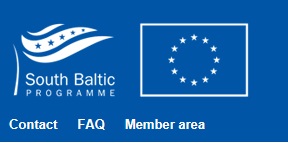 Going local. Meeting your needs. Connecting people and ideas.
Going local. Meeting your needs. Connecting people and ideas.
WHAT is the South Baltic Programme about?
The South Baltic Programme is a multilateral cross-border cooperation programme created on the maritime borders between the southern Baltic Sea regions. It is a new cooperation area where cross-border cooperation structures have not been set at a full scale yet. The overall objective of the Programme is to strengthen the sustainable development of the South Baltic area through joint actions increasing its competitiveness and enhancing integration among people and institutions.
Priorities of the South Baltic Programme are:
I Economic competitiveness
1.1. Entrepreneurial development
1.2. Integration of higher education and labour markets
1.3. Transport accessibility
II Attractiveness and common identity
2.1. Management of the Baltic Sea environment
2.2. Energy saving and renewable energy
2.3. Sustainable use of natural and cultural heritage for regional development
2.4. Local community initiatives
WHY the South Baltic Programme?
Because the Programme:
• Promotes both bilateral and multilateral co-operation;
• Focuses on co-operation over sea rather than over land borders;
• Supports unusual fields of co-operation – people to people contacts, youth or social issues, cultural exchange, and others;
• Cultivates the “cross-border co-operation heritage” in the South Baltic area;
• Fosters co-operation between regions;
• Acts close to beneficiaries – established network of Contact Points in Programme regions;
• Welcomes small, but well developed projects;
• Values soft outcomes, exchange and networking.
Potential beneficiaries of the SB programme are, for example:
Local, regional governments as well as their associations;
Non-governmental organisations (NGO's);
Schools, universities, and R&D institutions;
Institutions supporting and promoting sustainable development, innovation, and entrepreneurship;
other public institutions supporting and promoting sustainable development.
The South Baltic Programme is characterised by geographically large area encompassing regions from five European Union Members States. The area eligible for the Programme includes the following NUTS III units:
Poland
Koszalinski, Stargardzki, miasto Szczecin, Szczeciński, Slupski, Gdanski, Trojmiejski, Starogardzki, sub-regions and as adjacent area : Elblaski sub-region;
Sweden
Kalmar län, Blekinge län, Skåne län and as adjacent area: Kronobergs län;
Denmark
Bornholm and as adjacent area: Sjælland sub-regions: Østsjælland, Vest- og Sydsjælland
Germany
Sub-regions of Mecklenburg-Vorpommern: Greifswald, Rostock, Stralsund, Wismar, Bad Doberan, Nordvorpommern, Nordwestmecklenburg, Ostvorpommern, Rügen, Uecker-Randow;
Lihuania
Klaipedos apskritis and as adjacent area: Telsiu apskritis and Taurages apskritis.
Budget
The South Baltic Cross-border Co-operation Programme is co-financed by European Regional Development Fund (ERDF).
In 2007-2013 The European Union contribution to the Programme was 60 735 659 EUR. Total budget of programme was 75 342 210 EUR.
In 2014-2020 Total budget of programme is 83 100 000 EUR.
Co-financing rate
The co-financing rate from ERDF for Polish, Lithuanian, and German partners will be max. at 85% level. Swedish and Danish partners can receive from the ERDF up to 75% of the eligible expenditure.
Read more>>>
http://en.southbaltic.eu



 EUR 4.2563 zł
EUR 4.2563 zł USD 3.6432 zł
USD 3.6432 zł DKK 0.5704 zł
DKK 0.5704 zł SEK 0.382 zł
SEK 0.382 zł NOK 0.3597 zł
NOK 0.3597 zł